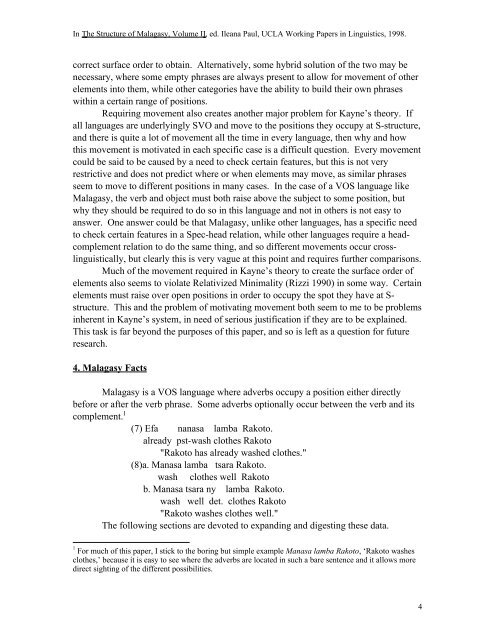Malagasy Adverbs Andrea Rackowski McGill University August 1996
Malagasy Adverbs Andrea Rackowski McGill University August 1996
Malagasy Adverbs Andrea Rackowski McGill University August 1996
You also want an ePaper? Increase the reach of your titles
YUMPU automatically turns print PDFs into web optimized ePapers that Google loves.
In The Structure of <strong>Malagasy</strong>, Volume II , ed. Ileana Paul, UCLA Working Papers in Linguistics, 1998.<br />
correct surface order to obtain. Alternatively, some hybrid solution of the two may be<br />
necessary, where some empty phrases are always present to allow for movement of other<br />
elements into them, while other categories have the ability to build their own phrases<br />
within a certain range of positions.<br />
Requiring movement also creates another major problem for Kayne’s theory. If<br />
all languages are underlyingly SVO and move to the positions they occupy at S-structure,<br />
and there is quite a lot of movement all the time in every language, then why and how<br />
this movement is motivated in each specific case is a difficult question. Every movement<br />
could be said to be caused by a need to check certain features, but this is not very<br />
restrictive and does not predict where or when elements may move, as similar phrases<br />
seem to move to different positions in many cases. In the case of a VOS language like<br />
<strong>Malagasy</strong>, the verb and object must both raise above the subject to some position, but<br />
why they should be required to do so in this language and not in others is not easy to<br />
answer. One answer could be that <strong>Malagasy</strong>, unlike other languages, has a specific need<br />
to check certain features in a Spec-head relation, while other languages require a headcomplement<br />
relation to do the same thing, and so different movements occur crosslinguistically,<br />
but clearly this is very vague at this point and requires further comparisons.<br />
Much of the movement required in Kayne’s theory to create the surface order of<br />
elements also seems to violate Relativized Minimality (Rizzi 1990) in some way. Certain<br />
elements must raise over open positions in order to occupy the spot they have at Sstructure.<br />
This and the problem of motivating movement both seem to me to be problems<br />
inherent in Kayne’s system, in need of serious justification if they are to be explained.<br />
This task is far beyond the purposes of this paper, and so is left as a question for future<br />
research.<br />
4. <strong>Malagasy</strong> Facts<br />
<strong>Malagasy</strong> is a VOS language where adverbs occupy a position either directly<br />
before or after the verb phrase. Some adverbs optionally occur between the verb and its<br />
complement. 1<br />
(7) Efa nanasa lamba Rakoto.<br />
already pst-wash clothes Rakoto<br />
"Rakoto has already washed clothes."<br />
(8)a. Manasa lamba tsara Rakoto.<br />
wash clothes well Rakoto<br />
b. Manasa tsara ny lamba Rakoto.<br />
wash well det. clothes Rakoto<br />
"Rakoto washes clothes well."<br />
The following sections are devoted to expanding and digesting these data.<br />
1 For much of this paper, I stick to the boring but simple example Manasa lamba Rakoto, ‘Rakoto washes<br />
clothes,’ because it is easy to see where the adverbs are located in such a bare sentence and it allows more<br />
direct sighting of the different possibilities.<br />
4
















